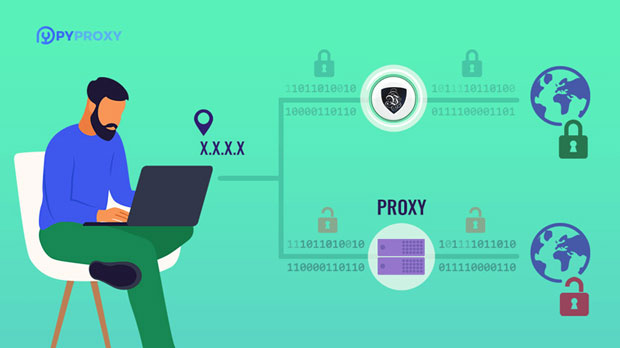A fast proxy server and a traditional VPN both serve the purpose of improving online security and privacy, but they function in fundamentally different ways. The key difference lies in how they handle your internet traffic and which aspects of your connection they secure. A proxy server typically works by routing your internet traffic through an intermediary server, masking your IP address but leaving other parts of your connection exposed. In contrast, a VPN (Virtual Private Network) encrypts all of your internet traffic, securing your entire connection. This article will explore the essential distinctions between these two technologies, providing clarity on their functionalities, advantages, and the practical implications for users. 1. Basic Functionality: How They OperateTo understand the key differences between a fast proxy server and a traditional VPN, it's essential to first grasp how each works. A proxy server functions as an intermediary between your device and the internet. When you request a webpage, your request goes to the proxy server, which then forwards it to the intended destination. The response is sent back to the proxy, which then passes it to you. While this can help conceal your IP address, it does not encrypt the data, leaving your connection vulnerable to interception.A VPN, on the other hand, creates an encrypted tunnel between your device and the VPN server. All your internet traffic, including data, browsing activities, and even DNS requests, is encrypted. This means that anyone attempting to intercept your data will only see an encrypted stream of information, ensuring higher levels of security. A VPN secures the entire connection, unlike a proxy, which primarily works for specific applications or websites.2. Privacy and Security: The Core DifferencePrivacy and security are the most significant aspects where a fast proxy server and a traditional VPN differ. A proxy server offers limited privacy protection. While it masks your IP address, it does not offer encryption, which means that third parties, such as hackers or internet service providers (ISPs), can still monitor your online activity. This makes proxies less secure compared to VPNs, especially when dealing with sensitive information or accessing public Wi-Fi networks.In contrast, a VPN provides a much higher level of security. The encryption used by VPNs not only hides your IP address but also secures the data you're sending over the internet. With a VPN, you can ensure that your activities remain private, even from ISPs or any malicious actors on the same network. This makes a VPN the preferred choice for users who require both privacy and security, particularly for tasks like online banking, remote work, or accessing sensitive business data.3. Speed and Performance: Proxy Server vs. VPNWhen it comes to speed and performance, a fast proxy server generally has the upper hand over a traditional VPN. Since a proxy server does not encrypt your traffic, it introduces less latency and consumes fewer system resources, resulting in faster speeds. This makes proxies ideal for users who are primarily concerned with bypassing geo-restrictions or accessing blocked content without the need for heavy encryption.However, the lack of encryption in a proxy also means that you are sacrificing security for speed. If your main concern is speed and you don’t need to protect sensitive data, a proxy can be a more efficient solution. On the other hand, VPNs, due to their encryption process, may introduce some degree of latency, which can result in slower connection speeds. But for users seeking a secure and private connection, the trade-off in speed is usually worth the added protection.4. Use Cases: Which One Is Right for You?The decision to use a fast proxy server or a traditional VPN depends largely on the use case and the level of security and privacy you require. If your primary goal is to access geo-restricted content, such as streaming services that are blocked in certain regions, a proxy server might be the better choice. Proxies are often used for lighter tasks, like browsing and streaming, where security isn’t a top priority.However, if you're looking to safeguard sensitive data, protect your privacy, or use public Wi-Fi networks securely, a VPN is the more suitable option. VPNs are especially useful for remote workers, business professionals, and anyone dealing with confidential information online. They provide comprehensive protection and ensure that all of your internet traffic is encrypted and safe from prying eyes.5. Compatibility and Flexibility: Customization OptionsWhen considering proxies and VPNs, one also needs to take compatibility and flexibility into account. Proxy servers typically offer a wider range of compatibility with specific applications and browsers. For example, many proxies are browser-based, meaning you can configure them directly within the browser settings. This allows for easy customization without requiring the installation of additional software. However, the scope of their coverage is limited, and they only work for specific apps or websites.In contrast, VPNs offer more comprehensive coverage. They protect all internet traffic on your device, not just specific applications or browsers. This level of security and flexibility makes VPNs a more appealing choice for users who require protection across all online activities, whether they’re browsing the web, using apps, or accessing business networks.6. Cost Considerations: Price vs. FunctionalityCost is another important factor to consider when comparing a fast proxy server with a traditional VPN. Proxy servers are generally more affordable than VPNs. Many proxy services offer free or low-cost options, especially for users who only need basic functionality, such as hiding their IP address for browsing or streaming. These lower costs, however, usually come with limitations in terms of security and functionality.VPNs tend to be more expensive due to the encryption technology they use and the comprehensive security features they provide. However, many users find the higher cost justified, especially when privacy and security are paramount. Some VPN providers offer a range of pricing tiers, depending on the level of service and features required. 7. Conclusion: Which Technology Is Best for You?In summary, both fast proxy servers and traditional VPNs have their own advantages and drawbacks. A proxy server is best suited for users who prioritize speed and are only concerned with hiding their IP address, while a VPN is ideal for those who need full encryption and security. Ultimately, your choice will depend on your specific needs—whether it's bypassing restrictions, maintaining privacy, or ensuring online security. While proxies are cheaper and faster, VPNs provide more robust protection, making them the better option for security-conscious users.
May 23, 2025


































































